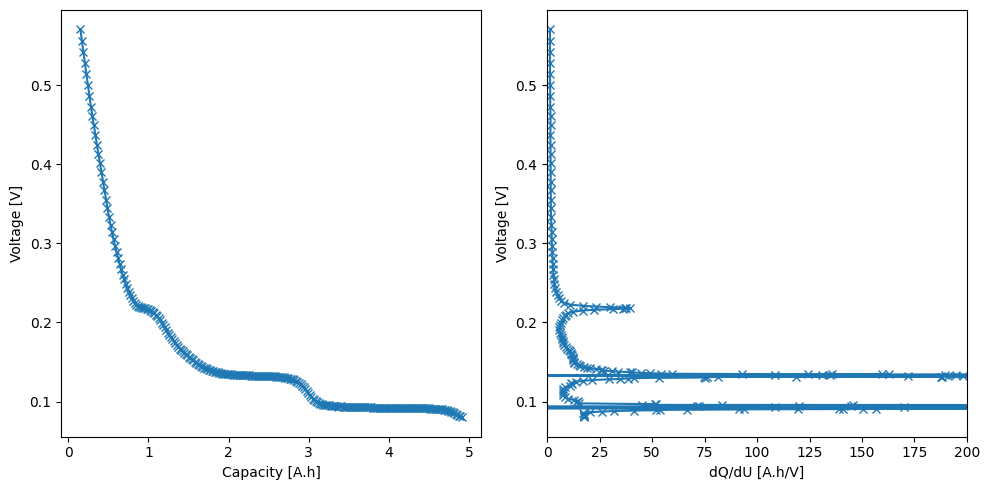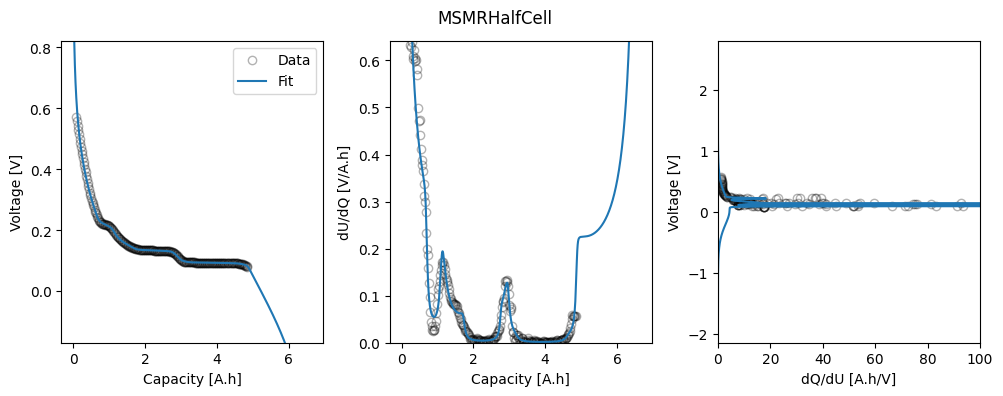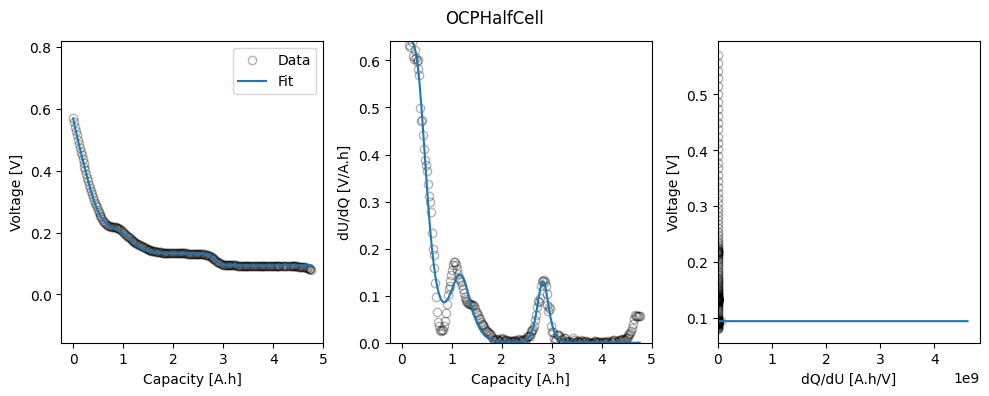Half-cell OCP fitting¶
In this example, we show how to fit the half-cell Open-Circuit Potential to pseudo-OCP data. Our recommended workflow for fitting OCPs is to first fit the MSMR model to the data and then create an interpolant to find a function \(U(x)\), where \(x\) is the stoichiometry. For comparison, we also show how to fit a function \(U(x)\) directly to pseudo-OCP data.
import ionworkspipeline as iwp
import numpy as np
import pandas as pd
import pybamm
import matplotlib.pyplot as plt
from scipy.signal import savgol_filter
/home/docs/checkouts/readthedocs.org/user_builds/ionworks-ionworkspipeline/envs/v0.8.2/lib/python3.12/site-packages/pybtex/plugin/__init__.py:26: UserWarning: pkg_resources is deprecated as an API. See https://setuptools.pypa.io/en/latest/pkg_resources.html. The pkg_resources package is slated for removal as early as 2025-11-30. Refrain from using this package or pin to Setuptools<81.
import pkg_resources
Pre-process and visualize the data¶
First, we load and pre-process the data.
# Load data
raw_ocp_data = pd.read_csv("anode_ocp_delithiation.csv", comment="#")
q = raw_ocp_data["Capacity [A.h]"].values
U = raw_ocp_data["Voltage [V]"].values
# Smooth
q_smoothed = savgol_filter(q, window_length=11, polyorder=1)
U_smoothed = savgol_filter(U, window_length=11, polyorder=1)
dQdU_smoothed = -np.gradient(q_smoothed, U_smoothed)
# Store in a dataframe
ocp_data = pd.DataFrame({"Capacity [A.h]": q_smoothed, "Voltage [V]": U_smoothed})
ocp_data = iwp.data_fits.preprocess.sort_capacity_and_ocp(ocp_data)
# Maximum capacity, will be used later as an initial guess for the electrode capacity
Q_max_data = ocp_data["Capacity [A.h]"].max()
# Plot
_, ax = plt.subplots(1, 2, figsize=(10, 5))
ax[0].plot(q_smoothed, U_smoothed, "-x")
ax[0].set_xlabel("Capacity [A.h]")
ax[0].set_ylabel("Voltage [V]")
ax[1].plot(dQdU_smoothed, U_smoothed, "-x")
ax[1].set_xlabel("dQ/dU [A.h/V]")
ax[1].set_ylabel("Voltage [V]")
ax[1].set_xlim(0, 200)
plt.tight_layout()
/home/docs/checkouts/readthedocs.org/user_builds/ionworks-ionworkspipeline/envs/v0.8.2/lib/python3.12/site-packages/numpy/lib/function_base.py:1242: RuntimeWarning: divide by zero encountered in divide
a = -(dx2)/(dx1 * (dx1 + dx2))
/home/docs/checkouts/readthedocs.org/user_builds/ionworks-ionworkspipeline/envs/v0.8.2/lib/python3.12/site-packages/numpy/lib/function_base.py:1243: RuntimeWarning: divide by zero encountered in divide
b = (dx2 - dx1) / (dx1 * dx2)
/home/docs/checkouts/readthedocs.org/user_builds/ionworks-ionworkspipeline/envs/v0.8.2/lib/python3.12/site-packages/numpy/lib/function_base.py:1244: RuntimeWarning: divide by zero encountered in divide
c = dx1 / (dx2 * (dx1 + dx2))
/home/docs/checkouts/readthedocs.org/user_builds/ionworks-ionworkspipeline/envs/v0.8.2/lib/python3.12/site-packages/numpy/lib/function_base.py:1250: RuntimeWarning: invalid value encountered in add
out[tuple(slice1)] = a * f[tuple(slice2)] + b * f[tuple(slice3)] + c * f[tuple(slice4)]

Fit the MSMR model to data¶
We begin by getting literature values for the MSMR parameters from the ionworkspipeline library
lib = iwp.Library()
gr = lib["Graphite - Verbrugge 2017"]
gr_params = gr.parameter_values
This gives us initial guesses for the MSMR species parameters (\(X_j\), \(U^0_j\), and \(w_j\)). We also need estimates for the total electrode capacity and lower excess capacity. We can use the helper function get_initial_capacity_and_lower_excess_capacity to estimate these from the species parameters and data
gr_params.update(
iwp.data_fits.objectives.get_initial_capacity_and_lower_excess_capacity(
gr_params, "negative", ocp_data
)
)
We can plot these against the data and, if required, manually adjust them to get a better starting point. For this example, let’s keep the Graphite parameters as our initial guess.
fig, ax = iwp.objectives.plot_each_species_msmr(
ocp_data, gr_params, "negative", voltage_limits=(0, 1.5)
)
_ = ax[1].set_xlim(0, 50)

Now we can set up the objective and parameters to fit, run the data fit and plot the results.
# Loop over the initial guesses and set up the parameters to fit with appropriate bounds
parameters_to_fit = {}
for k, v in iwp.parameter_values.scalarize_dict(gr_params).items():
if "host site occupancy fraction" in k:
bounds = (0, 1)
elif "host site standard potential" in k:
bounds = (max(0, v - 0.5), v + 0.5)
elif "host site ideality factor" in k:
bounds = (1e-2, 100)
elif "lower excess" in k:
bounds = (0, 0.1 * Q_max_data)
elif "capacity" in k:
bounds = (Q_max_data, 1.5 * Q_max_data)
else:
continue
parameters_to_fit[k] = iwp.Parameter(k, initial_value=v, bounds=bounds)
# Calculate dUdQ cutoff to prevent overfitting to extreme dUdQ values
dUdq_cutoff = iwp.data_fits.util.calculate_dUdQ_cutoff(ocp_data)
# Set up model, objective and fit
model = iwp.data_fits.models.MSMRHalfCellModel(
"negative", options={"species format": "Xj"}
)
objective = iwp.data_fits.objectives.MSMRHalfCell(
ocp_data, options={"model": model, "dUdQ cutoff": dUdq_cutoff}
)
ocp_msmr = iwp.DataFit(
objective,
parameters=parameters_to_fit,
)
# Run the fit
results = ocp_msmr.run({"Ambient temperature [K]": 298.15})
# Plot results
fig_ax = ocp_msmr.plot_fit_results()
axes = fig_ax["MSMRHalfCell"][0][1]
_ = axes[2].set_xlim(0, 100)

Lastly, we can look at the fitted parameters.
ocp_msmr.results
Result(
Negative electrode host site ideality factor: [0.019526510055650457, 0....
Negative electrode host site standard potential [V]: [0.092301148834443...
Negative electrode host site occupancy fraction: [0.21916745240179422, ...
Negative electrode capacity [A.h]: 6.63447
Negative electrode lower excess capacity [A.h]: 0.0866398
)
We can access tabulated capacity vs OCP data from the MSMR callback
outputs = results.callbacks["MSMRHalfCell"].callbacks[0].fit_results_["outputs"]
q = outputs["Capacity [A.h]"]
U = outputs["Voltage [V]"]
ocp_fit_data = pd.DataFrame({"Capacity [A.h]": q, "Voltage [V]": U})
ocp_fit_data.head()
| Capacity [A.h] | Voltage [V] | |
|---|---|---|
| 0 | 0.036630 | 0.570425 |
| 1 | 0.046742 | 0.556259 |
| 2 | 0.057644 | 0.542092 |
| 3 | 0.069388 | 0.527926 |
| 4 | 0.082033 | 0.513760 |
Fit OCP as a function of stoichiometry¶
Now, we directly fit a function \(U(x)\) to the pseudo-OCP data.
First, we define the function and initial guesses for the parameters.
def U_half_cell(theta):
u00 = pybamm.Parameter("u00_pos")
u10 = pybamm.Parameter("u10_pos")
u11 = pybamm.Parameter("u11_pos")
u20 = pybamm.Parameter("u20_pos")
u21 = pybamm.Parameter("u21_pos")
u22 = pybamm.Parameter("u22_pos")
u30 = pybamm.Parameter("u30_pos")
u31 = pybamm.Parameter("u31_pos")
u32 = pybamm.Parameter("u32_pos")
u40 = pybamm.Parameter("u40_pos")
u41 = pybamm.Parameter("u41_pos")
u42 = pybamm.Parameter("u42_pos")
u_eq = (
u00
+ u10 * pybamm.exp(-u11 * theta)
+ u20 * pybamm.tanh(u21 * (theta - u22))
+ u30 * pybamm.tanh(u31 * (theta - u32))
+ u40 * pybamm.tanh(u41 * (theta - u42))
)
return u_eq
ocp_param_init = {
"u00_pos": 0.2,
"u10_pos": 2,
"u11_pos": 30,
"u20_pos": -0.1,
"u21_pos": 30,
"u22_pos": 0.1,
"u30_pos": -0.1,
"u31_pos": 30,
"u32_pos": 0.3,
"u40_pos": -0.1,
"u41_pos": 30,
"u42_pos": 0.6,
}
Then we set up our DataFit object and fit the data.
# Set up Parameter objects to fit
ocp_params = {k: iwp.Parameter(k, initial_value=v) for k, v in ocp_param_init.items()}
# Add the functional form of the OCP
ocp_params = {"Positive electrode OCP [V]": U_half_cell, **ocp_params}
# Use the experimental capacity to map between capacity in the experiment and the
# stoichiometry. In practice we would calculate the capacity from other means,
# (e.g. electrode loading) or use the MSMR model to fit the electrode capacity.
known_parameter_values = {"Positive electrode capacity [A.h]": Q_max_data}
# Set up objective and fit
objective = iwp.objectives.OCPHalfCell(
"positive",
ocp_data,
)
ocp = iwp.DataFit(objective, parameters=ocp_params)
# Fit
params_fit_ocp = ocp.run(known_parameter_values)
# Plot
_ = ocp.plot_fit_results()

Then, we look at the fitted parameters.
params_fit_ocp
Result(
Positive electrode OCP [V]: <function U_half_cell at 0x795bb01c60c0>
u00_pos: 0.26766
u10_pos: 0.148291
u11_pos: 21.9377
u20_pos: -0.115899
u21_pos: 17.9201
u22_pos: 0.0648092
u30_pos: -0.0381474
u31_pos: 17.4306
u32_pos: 0.246712
u40_pos: -0.0194789
u41_pos: 32.1578
u42_pos: 0.593834
)